Discover the culinary artistry of Bicol with Sinanglay na Tilapia, an elegant preparation where fresh fish is delicately stuffed with tomatoes and shallots, wrapped in vibrant pechay leaves, and gently simmered in rich coconut milk.
This traditional method of cooking fish not only preserves its natural moisture but also infuses it with layers of flavor from aromatic pandan leaves and mild chilies.
Perfect for both family meals and special occasions, this dish showcases the sophisticated simplicity of Filipino regional cuisine, where fresh ingredients and time-honored techniques come together to create something truly exceptional.
Jump to:
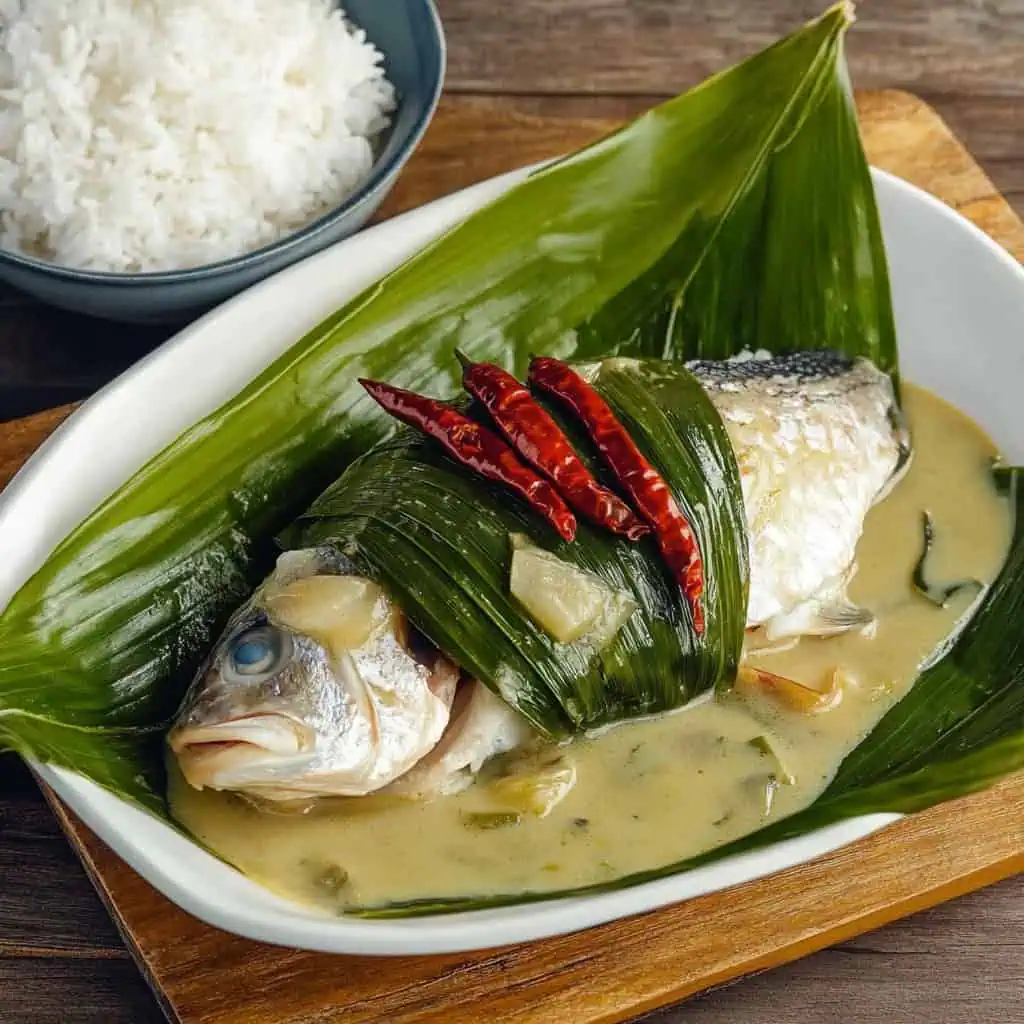
Why You'll Love This Recipe
- Unique Cooking Method: The fish is wrapped in pechay leaves, creating a natural steam pocket that keeps the fish incredibly moist
- Rich and Creamy: The gata (coconut milk) creates a luscious sauce that's perfect with rice
- Healthy Option: Steamed fish with vegetables makes for a nutritious meal
- Make-Ahead Friendly: Can be prepared in advance and reheated
- Impressive Presentation: The wrapped fish parcels make for a stunning table centerpiece
Ingredients
The ingredients in Sinanglay na Tilapia create a perfect harmony of flavors and textures. Fresh tilapia serves as the delicate base while tomatoes and shallots add sweetness and aromatic depth to the stuffing. Ginger brings warmth and helps counter any fishiness, while tamarind adds a bright, tangy note.
The pechay leaves aren't just for wrapping, they infuse the dish with earthy flavors and nutrients as they cook. Coconut milk creates a luxurious sauce that balances the subtle heat from finger chilies, while pandan leaves contribute their unique aroma.
This thoughtful combination showcases the Bicolano cooking philosophy of balancing rich, creamy textures with fresh, vibrant flavors, resulting in a dish that's both comforting and sophisticated.
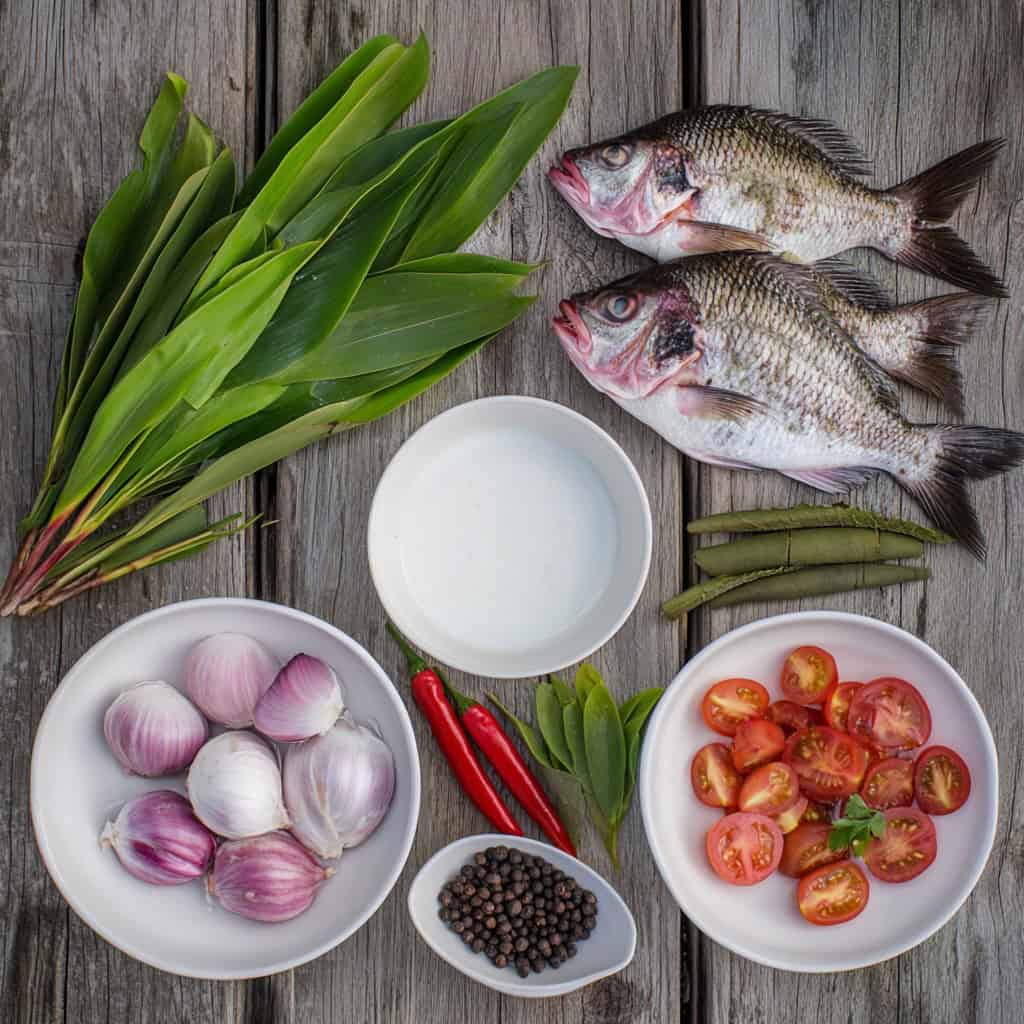
For the Fish:
- 2 whole tilapia (about 500g each), cleaned and scaled
- Salt and pepper to taste
For the Stuffing:
- 2 large Roma tomatoes, diced
- 4 shallots, peeled and chopped
- 1 thumb-sized ginger, minced
- 1 teaspoon tamarind powder or 1 tablespoon calamansi juice
For Wrapping and Sauce:
- 2 bunches large pechay leaves, stems trimmed
- 4 pandan leaves, about 1 foot long each
- 1 can (400ml) thick coconut milk
- 2-3 finger chilies (siling haba)
- Salt and pepper to taste
Equipment
- Large Kawali or Deep Pan (20-inch diameter) - Provides adequate space for cooking the wrapped fish without overcrowding
- Kitchen Twine or Pandan Leaves - Essential for securing the pechay leaf wrapping around the fish
- Sharp Knife - For cleaning the fish properly and precise cutting of ingredients
- Chopping Board - Separate boards for fish and vegetables recommended for food safety
- Measuring Cups and Spoons - Ensures the right balance of flavors
- Large Bowl - For combining stuffing ingredients evenly
- Tongs - For safely handling the wrapped fish packages during cooking
- Heavy Lid - Helps maintain steady temperature and proper steam circulation
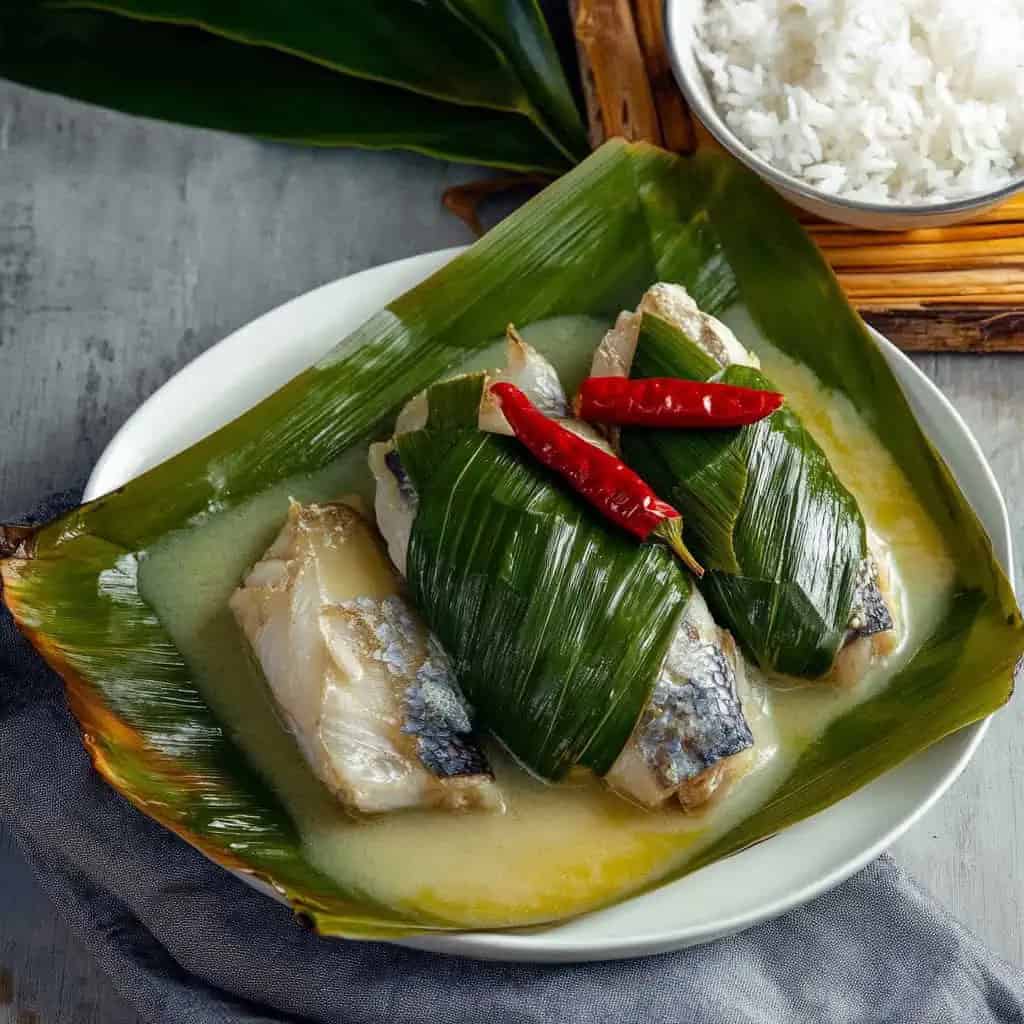
How To Make
- Thoroughly clean your tilapia by removing all scales, innards, and gills. Rinse under cold water and pat dry with paper towels. Season the fish inside and out with salt and pepper.
- In a bowl, combine the chopped tomatoes, shallots, and ginger. Add the tamarind powder and mix until well incorporated.
- Carefully fill each fish cavity with the tomato mixture, being mindful not to overstuff.
- Wash the pechay leaves and thoroughly pat them dry. Arrange 2-3 leaves slightly overlapping each other to create a sturdy wrapping surface.
- Place a stuffed fish in the center of the pechay leaves. Wrap the leaves around the fish, then secure with pandan leaves or kitchen twine. Repeat with the second fish.
- Arrange the wrapped fish parcels in a large pan. Pour in the coconut milk and add the finger chilies. Season with additional salt and pepper to taste.
- Cover the pan and bring to a gentle simmer over low heat. Maintain a gentle heat with just tiny bubbles breaking the surface, never allow it to boil rapidly. Cook for 20-25 minutes.
- The fish is done when the flesh turns opaque and flakes easily when tested with a fork.
- Allow to rest for 5 minutes before serving. Transfer to a serving platter and pour the creamy coconut sauce over the top. Serve hot with steamed rice.
Remember: Keep the heat low and steady throughout cooking to prevent the coconut milk from curdling. Gentle cooking results in a creamier, more luxurious sauce.

Tips from Lola's Kitchen
- Choose the freshest tilapia by looking for clear eyes, bright red gills, and firm flesh that springs back when pressed
- Remove fish blood completely from along the backbone to prevent any bitter taste
- Pat tomatoes dry or squeeze out excess juice to prevent a watery sauce
- Never let coconut milk reach a full boil as this causes separation and curdling
- Select younger pechay leaves which are more pliable and easier to wrap around the fish
- Let the fish parcels rest for 5 minutes after cooking to allow flavors to fully develop and be absorbed
- Handle the wrapped parcels gently when checking for doneness to prevent them from falling apart
- Season in layers - season the fish, the stuffing, and the sauce separately for depth of flavor
Substitutions
- Fish: Bangus (milkfish), pompano, or maya-maya (red snapper) can replace tilapia
- Pechay: Substitute with mustard leaves, collard greens, or gabi (taro) leaves
- Pandan leaves: Use banana leaves for wrapping or food-grade twine if leaves are unavailable
- Tamarind powder: Replace with fresh calamansi juice, lime juice, or kamias (bilimbi)
- Shallots: Regular red onions or white onions work as alternatives
- Coconut milk: Use powdered coconut milk reconstituted with water if fresh or canned is unavailable
- Finger chilies: Bell peppers for a milder version or bird's eye chilies for extra heat
Troubleshooting
Sauce is too thin:
- Simmer uncovered for an additional 5-10 minutes to reduce
- Use first-press coconut milk (kakang gata) which is naturally thicker
- Add 1 teaspoon of cornstarch mixed with water as a last resort
Fish falls apart during cooking:
- Wrap more securely with multiple layers of pechay leaves
- Handle very gently when checking doneness
- Ensure you're not overcooking the fish
- Use kitchen twine in addition to pandan leaves for extra security
Bitter taste in the dish:
- Ensure all blood is completely removed from the fish
- Avoid using mature, tough pechay leaves which can be bitter
- Check that the coconut milk hasn't curdled due to high heat
- Remove the central vein from finger chilies where much of the bitterness resides
Storage & Reheating
Storage:
- Refrigerator: Store in an airtight container for up to 3 days
- Freezer: Not recommended as freezing affects the texture of both fish and sauce
Reheating:
- Stovetop: Place in a covered pan and heat gently for 5-7 minutes on low heat
- Microwave: Heat for 2-3 minutes at 50% power, checking halfway
- Add a splash of water or fresh coconut milk if the sauce has thickened too much
- Allow to come to room temperature before reheating for more even warming
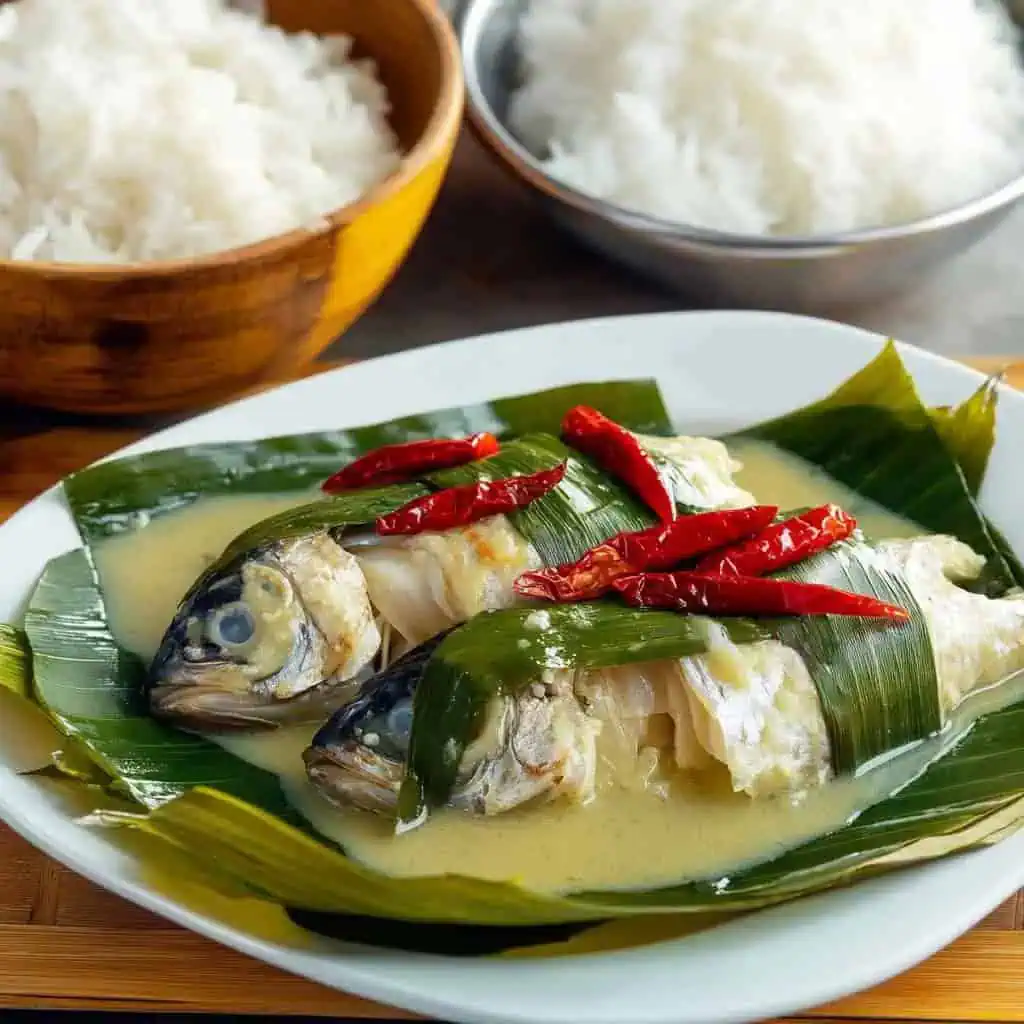
FAQ
Can I prepare this dish in advance for a party?
Yes, you can prepare everything up to the wrapping stage and refrigerate for up to 12 hours. Cook just before serving for the best results.
How can I make this dish less spicy for children?
Remove the chilies completely before cooking or use only one mild chili that can be removed after cooking. Bell peppers provide color without heat.
Why does my coconut milk always curdle?
Coconut milk curdles when exposed to high heat. Keep temperature low and steady, never allowing it to boil. Stir occasionally and gently during cooking.
Can I use frozen tilapia for this recipe?
Fresh is always best, but thawed tilapia works if patted completely dry before use. The texture may be slightly different but still delicious.
How do I know exactly when the fish is done without unwrapping it?
After about 20 minutes, carefully open one parcel slightly and check if the flesh is opaque and flakes easily with a fork. The internal temperature should reach 145°F (63°C).
What makes Bicolano cooking different from other Filipino cuisines?
Bicolano cuisine is distinguished by its generous use of coconut milk and chili peppers. This region masterfully balances creamy, spicy, and tangy flavors in dishes like Sinanglay.
Can I add vegetables to the coconut sauce?
Yes! Sliced eggplant, okra, or bell peppers added during the last 10 minutes of cooking absorb the flavors beautifully and make this a complete one-pot meal.
Related
Looking for other recipes like this? Try these:
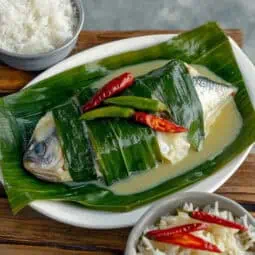
Sinanglay na Tilapia (Bicolano Fish in Coconut Milk)
Equipment
- Large Kawali or Deep Pan (20-inch diameter) For cooking the fish parcels
- Kitchen Twine or Pandan Leaves For securing the wrapping
- Sharp knife For cleaning fish and chopping ingredients
- Chopping Board Separate boards for fish and vegetables recommended
- Measuring cups and spoons For precise ingredient portions
- Large Bowl For mixing stuffing ingredients
- Tongs For carefully handling the wrapped fish
- Heavy lid To ensure proper steam circulation
Ingredients
For the Fish:
- 2 whole tilapia about 500g each, cleaned and scaled (isda)
- Salt asin and pepper (paminta) to taste
For the Stuffing:
- 2 large Roma tomatoes diced (kamatis)
- 4 shallots peeled and chopped (sibuyas tagalog)
- 1 thumb-sized ginger minced (luya)
- 1 teaspoon tamarind powder sampalok or 1 tablespoon calamansi juice
For Wrapping and Sauce:
- 2 bunches large pechay leaves stems trimmed
- 4 pandan leaves dahon ng pandan, about 1 foot long each
- 1 can 400ml thick coconut milk (kakang gata)
- 2-3 finger chilies siling haba
- Salt and pepper to taste
Instructions
- Start by cleaning your tilapia thoroughly. Remove all scales, innards, and gills, then rinse under cold water and pat dry with paper towels. Season the fish inside and out with salt and pepper.
- Mix together the chopped tomatoes, shallots, and ginger in a bowl. Add the tamarind powder and stir until well combined.
- Fill each fish cavity with the tomato mixture, being careful not to overstuff.
- Wash your pechay leaves and pat them completely dry. Lay out 2-3 leaves slightly overlapping each other.
- Place a stuffed fish in the center of the pechay leaves. Wrap the leaves around the fish, then tie securely with pandan leaves or kitchen twine. Repeat with the second fish.
- Place your wrapped fish parcels in a large pan. Pour in the coconut milk and add the finger chilies. Season with a little more salt and pepper.
- Cover the pan and bring to a gentle simmer over low heat. Never let it boil rapidly - you want just tiny bubbles breaking the surface. Cook for 20-25 minutes.
- You'll know the fish is done when the flesh turns opaque and flakes easily when tested with a fork.
- Let rest for 5 minutes before serving. Place on a serving platter and pour the creamy coconut sauce over the top. Serve hot with steamed rice.
- Remember: Keep the heat low and steady throughout cooking to prevent the coconut milk from curdling. The gentler you cook it, the creamier your sauce will be.
Tips from Lola's Kitchen
- Always choose fresh tilapia with clear eyes and bright red gills
- Remove fish blood completely to prevent bitter taste
- Squeeze excess water from tomatoes to prevent watery sauce
- Never let coconut milk boil to prevent curdling
- Use younger pechay leaves for better wrapping
- Let fish rest 5 minutes before serving to absorb flavors
Nutrition
The Story Behind Sinanglay na Tilapia
In the verdant region of Bicol, where coconut trees sway endlessly and chilies grow in abundance, Sinanglay na Tilapia emerged as a testament to the ingenuity of Filipino regional cuisine. This method of wrapping fish in leaves and cooking it in coconut milk isn't just a recipe—it's a culinary narrative that spans generations of Bicolano home cooks and their deep understanding of local ingredients.
The tradition of "sinanglay" speaks to the region's mastery of coconut milk cooking, a technique that predates Spanish colonization. While the recipe now commonly uses tilapia, historical records suggest that the method was originally used with native river fish caught fresh from Bicol's winding waterways. The technique was born from necessity—wrapping fish in leaves helped preserve its freshness in the tropical heat while creating a natural steaming pocket that infused the meat with complex flavors.
What makes Sinanglay distinct from other Filipino coconut milk-based dishes is its sophisticated layering of flavors. The pechay leaves used for wrapping aren't merely a cooking vessel; they contribute a subtle earthiness that complements the creamy coconut milk. The stuffing of tomatoes, shallots, and ginger—ingredients native to Philippine soil—creates an aromatic trinity that has become the dish's signature.
Modern iterations of Sinanglay na Tilapia showcase the dish's adaptability. While traditionalists might have used alibangbang leaves or gabi leaves for wrapping, pechay has become the contemporary choice for its availability and mild flavor. The dish demonstrates how Bicolano cuisine continues to evolve while maintaining its cultural integrity. Today, you'll find this beloved recipe served in both humble Filipino homes and upscale restaurants, proving that authentic regional dishes can transcend social boundaries while remaining true to their roots.
Particularly fascinating is how Sinanglay exemplifies the Bicolano principle of "layering" flavors—a cooking philosophy where each ingredient adds a distinct note to the final dish. The coconut milk doesn't just provide richness; it serves as a bridge between the fresh fish, aromatic vegetables, and leafy wrapper. This thoughtful composition reflects the sophisticated culinary thinking that has always been present in Philippine regional cooking.
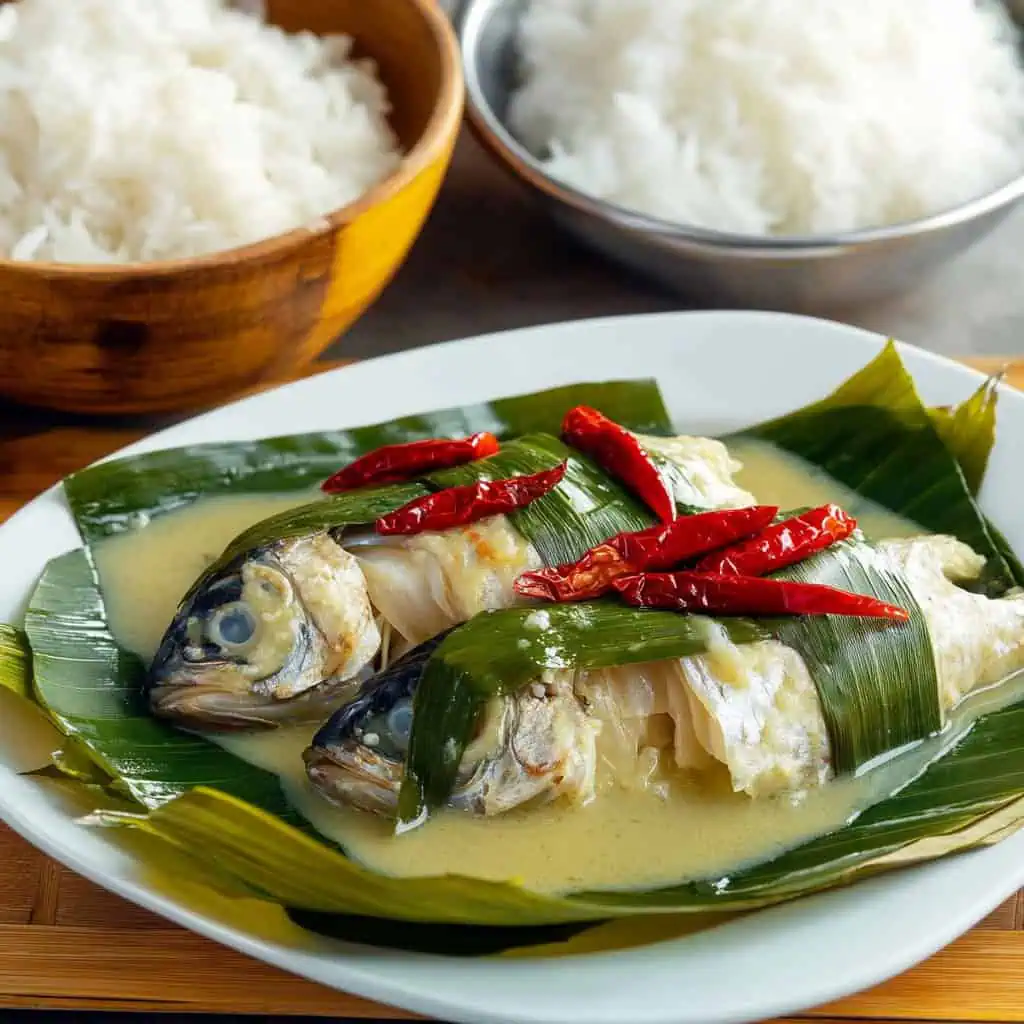









Comments
No Comments